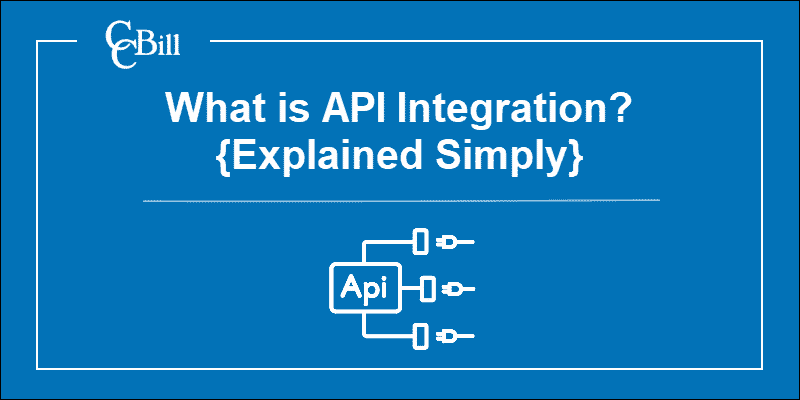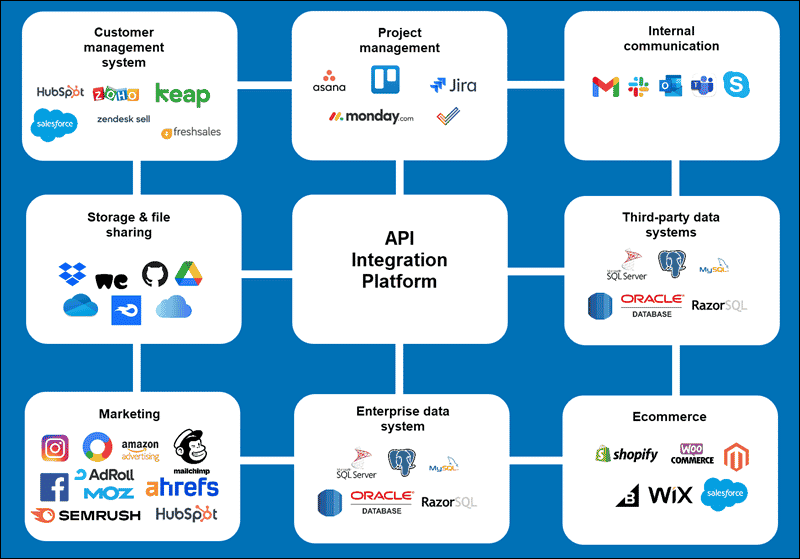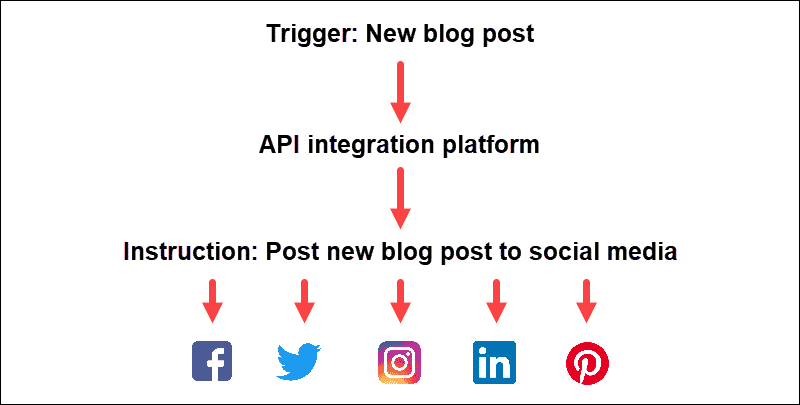Introduction
While certain businesses manage to operate smoothly with only a handful of software applications, most modern-day businesses rely on a tech stack that includes tens or even hundreds of programs.
Software requires data to perform its role. The data can be collected automatically, entered manually, or imported from another system or application. The demand for quick service and access to information makes manual data entry a suboptimal solution. APIs and API integration satisfy this need for fast data flow.
Find out what API integration is, what its benefits are, and how to accomplish it.

What is an API Integration?
API integration (also called API connectivity) is the act of connecting two or more applications via APIs to create a data network and enable real-time data exchange. This data exchange can be programmed to happen automatically after a certain activity, called an event or trigger.
The typical use of API integration is to create a series of automated tasks, called automated workflows. Automation saves time and money that would otherwise be spent performing these tasks manually.

API Integration Example
Suppose a company regularly publishes blog posts and shares them on social media. Sharing one blog post manually on every social media platform does not take much time. However, repeating the same simple task for every new blog post results in a lot of valuable time lost.
An API integration can be used to set up an automated process that shares every new blog post on the company’s social media pages as soon as it is published. In this case, the trigger for the automated process is the publication of a new blog post. The API integration reacts to the trigger and picks up relevant information such as the blog post’s URL and metadata.
The API integration then instructs social media APIs to share the published blog and forwards the URL and metadata. The new blog post appears on social media pages within seconds after its publication.

This is only one of the countless examples of workflow automation via API integration.
How is API Integration Achieved?
API integration is accomplished using one of three ways:
- API integration platforms and tools
- REST connector APIs
- Custom solutions
API Integration Platforms and Tools
API integration platforms and tools are software that allow easy overview and management of multiple APIs and their integrations. Some API integration tools connect department-related applications (for example, sales, marketing, and customer relationship management platforms) while others connect systems of any category.
API integration platforms typically perform tasks such as:
- Connecting data sources
- Integrating cloud apps
- Publishing APIs
- Connecting to legacy systems
- Creating new APIs
- Individual API management and maintenance
- Ensuring future scaling and integration capabilities
Most platforms have a graphic user interface (GUI) and do not require developer-level knowledge. In addition, many platforms connect not only APIs, but also service-oriented architectures (SOAs) and Software-as-a-Service (SaaS) applications.
The most popular API integration platforms include:
REST Connector APIs
REST connector APIs are intermediary APIs that connect to enterprise and third-party REST endpoints. The connector communicates with the client and server using the HTTPS protocol and XML or JSON data format.
Benefits of connectors over direct API calls are:
- Connectors eliminate the need for individual connection and data extraction systems, reducing development costs.
- Calls made through connectors are logged, resulting in extensive diagnostic information and easier debugging.
- API design is consistent.
- Updates, testing, and migration are easy to perform.
Custom API Integration Solutions
Custom API solutions are unique API connection solutions developers make to address a particular issue. Because of their unique and hand-written nature, custom API solutions come with certain disadvantages.
- They require time for development and testing, unlike out-of-the-box solutions that are instantly ready for use.
- They are written by a person who must possess deep knowledge and understanding of the API server’s documentation.
- Development, testing, and maintenance cost more than ready-made solutions.
10 API Integration Benefits
Organizations benefit greatly from integrating with an API service that upgrades their own product. These are the advantages of API integration:
1. Speed
System-to-system communication is the quickest way to transfer information. In addition, task automation is much faster than manual data entry.
2. Data Accuracy
API integration minimizes errors because information flows from one source to another, without human involvement.
3. Optimized Resource Allocation
Companies use API integration to automate departmental tasks and processes, resulting in better resource allocation. Valuable funds and human resources that would be spent on repetitive and time-consuming work can now be used for high-priority tasks that cannot be automated.
4. Improved Operational Efficiency
API integration positively affects a business's operational efficiency. Automated tasks can be performed 24/7/365. APIs experience downtimes only during hotfixes, maintenance updates, and system or client updates.
5. Data Centricity
API integration is an efficient tool for data collection and analysis. Data that can be collected with an API includes data from the API server’s database and API call logs. Insights gained this way allow companies to optimize API usage and improve their data system and tech stack.
6. Improved Marketing
When it comes to digital marketing, banners are effective, but dynamic ads take the lead. Dynamic ads (also called dynamic banners) consist of a catalog of advertisements. The element shown on the banner is selected according to the preferences of the end-user and any ongoing promotional activities of the company.
7. Improved Communication
API integration gives stakeholders real-time data access. Stakeholders can always return and check the data, reducing the need for redundant communication and data requests. In addition, reporting within the enterprise and to third-party stakeholders is much easier thanks to access to real-time and factual data.
8. Reduced Development Costs
Software companies often use API integration to implement new features and functionalities into their existing programs. This is beneficial if:
- The company does not have the capacity to work on such features but deems them valuable to end-users.
- The company is buying time for in-house development of additional features.
- The company finds letting a third party handle the feature’s maintenance more beneficial.
For example, if you are looking to add payment processing to your ecommerce smartphone app, you could do so by integrating with a payment API. The API you integrate with would provide the required feature without you having you having to build a custom solution.
9. Optimal Usage of a Company's Tech Stack
Automating tasks via API integration ensures the optimal usage of a company's tech stack by:
- Ensuring maximum use of every application in the company's tech stack
- Guaranteeing the completion of all scheduled tasks
10. Better Decision Making
Successful API integration results in real-time data access, leading to data-driven company decisions. Even if a decision proves to be wrong, successful API integration allows quick identification and correction of the issue.
Conclusion
API integration is not only beneficial, but necessary. Thanks to API integration, legacy systems can communicate with modern software solutions, allowing companies to easily transition to cloud-based environments.
The best API integration solution for a business depends on its needs, business model, and capabilities.
